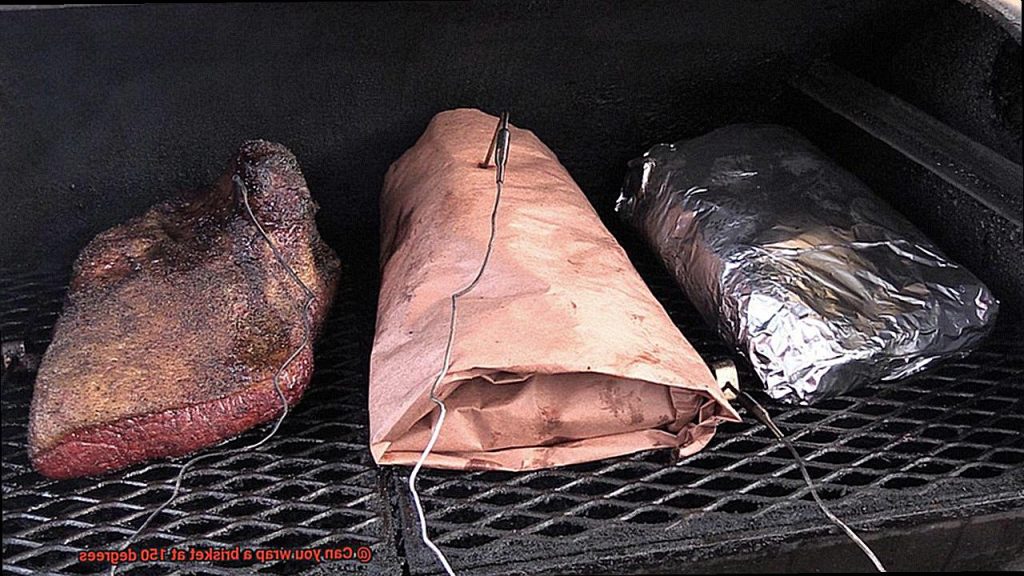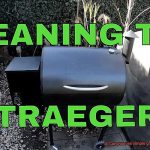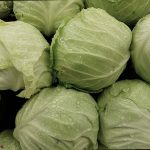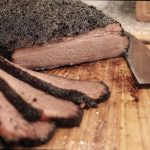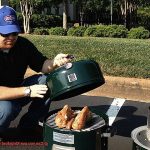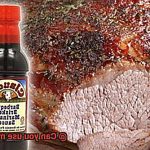Picture this: a juicy, smoky brisket that melts in your mouth with every bite. It’s the stuff of BBQ dreams, but it takes time and patience to achieve perfection. One of the biggest debates among pitmasters is whether or not to wrap brisket at a specific temperature. It’s no wonder newbies are scratching their heads trying to figure out the best approach.
So, let’s get down to business: can you wrap a brisket at 150 degrees? The answer isn’t black and white. Wrapping brisket is an art form that aims to speed up cooking while maintaining moisture levels. But if you wrap too early or too late, you risk ruining the texture and flavor of your meat.
In this blog post, we’ll take a deep dive into the world of brisket wrapping and explore whether 150 degrees is the sweet spot. We’ll cover everything from why wrapping is beneficial to when to wrap and what temperatures will give you that perfect bark. Whether you’re new to BBQ or a seasoned pro looking for some tips, buckle up and get ready to learn all about wrapping brisket at 150 degrees.
Contents
Can You Wrap A Brisket At 150 Degrees?
Cooking a brisket is an art that requires patience, skill, and knowledge. One of the most important steps in the process is wrapping the meat in foil or butcher paper. This helps to retain moisture and flavor, but there are debates about when to wrap and at what temperature.
One common question among grill enthusiasts is whether it’s possible to wrap a brisket at 150 degrees. The idea is to speed up the cooking process and prevent the meat from drying out. However, some argue that wrapping too early can result in a soggy and mushy texture.
To answer this question, we need to delve deeper into the science of brisket cooking. Different temperatures affect the meat differently, and personal preferences also play a role. We’ll explore the topic of wrapping a brisket at 150 degrees in detail and provide expert insights and tips for achieving a perfectly cooked and juicy brisket.
Firstly, let’s talk about why wrapping a brisket is important. Wrapping helps to retain moisture, cook the meat more evenly, and speed up the cooking process. At 150 degrees, your brisket is likely in the stall phase, which can be frustrating for those who want their meat to cook quickly and evenly. Wrapping the brisket at this point can help push through the stall and get the meat to its target temperature faster.
However, some grillers argue that wrapping too early or too tightly can cause the brisket to steam instead of smoke, resulting in a less desirable texture. And others prefer not to wrap at all as they believe it impacts the flavor and texture of the meat.
So what’s the verdict? Well, it ultimately comes down to personal preference and experience. If you’re new to grilling brisket, it may be worth experimenting with both wrapped and unwrapped methods to see which produces the best results for you. And remember to keep in mind factors such as the type of smoker or grill being used and the size of the brisket.
What is Wrapping/Texas Crutch?
If you’ve ever indulged in succulent, flavorful barbecue, then you know that each bite is a result of the perfect cook. One popular technique used by pitmasters to achieve this level of deliciousness is Wrapping, also known as the Texas Crutch. Wrapping involves enveloping your meat in foil or butcher paper during the cooking process to create a steamy environment that helps break down connective tissue and keeps the meat from drying out.
Thanks to the Texas Crutch, pitmasters can speed up the cooking process while still producing tender, juicy meats. Wrapping is particularly helpful when cooking tough cuts of meat that require long cook times, such as brisket and pork shoulder. Pitmasters usually wrap their meat when it reaches an internal temperature of around 150-160 degrees Fahrenheit after several hours of cooking over low and slow heat.
However, there’s a trade-off when it comes to wrapping your meat. While it speeds up the cooking process and keeps your meat moist, it can shorten the time in which smoke flavor is absorbed by the meat. Some pitmasters prefer to skip wrapping altogether and rely on a longer cook time to achieve tender, flavorful meat with a smoky bark.
Why Wrap a Brisket at 150 Degrees?
Smoking a brisket is a labor of love that requires time, skill, and patience. One of the most critical elements in the process is knowing when and how to wrap the meat. Wrapping a brisket at 150 degrees Fahrenheit is a popular technique among pitmasters because it can make all the difference between a dry and tough brisket or a moist and tender masterpiece.
At 150 degrees Fahrenheit, the brisket has already been smoking for several hours, developing a delicious crust on the outside. Wrapping it in foil or butcher paper helps to lock in moisture and create a steamy environment around the meat. This steam then goes to work, breaking down the tough connective tissue in the brisket, transforming it into succulent, juicy meat that falls apart with ease.
Timing is crucial when it comes to wrapping a brisket. Wrap too early, and you may end up with a mushy texture and lack of bark. Wrap too late, and you could end up with a dry and tough brisket. Wrapping at 150 degrees gives you the best of both worlds – enough smoke flavor and bark on the outside while retaining moisture and tenderness on the inside.
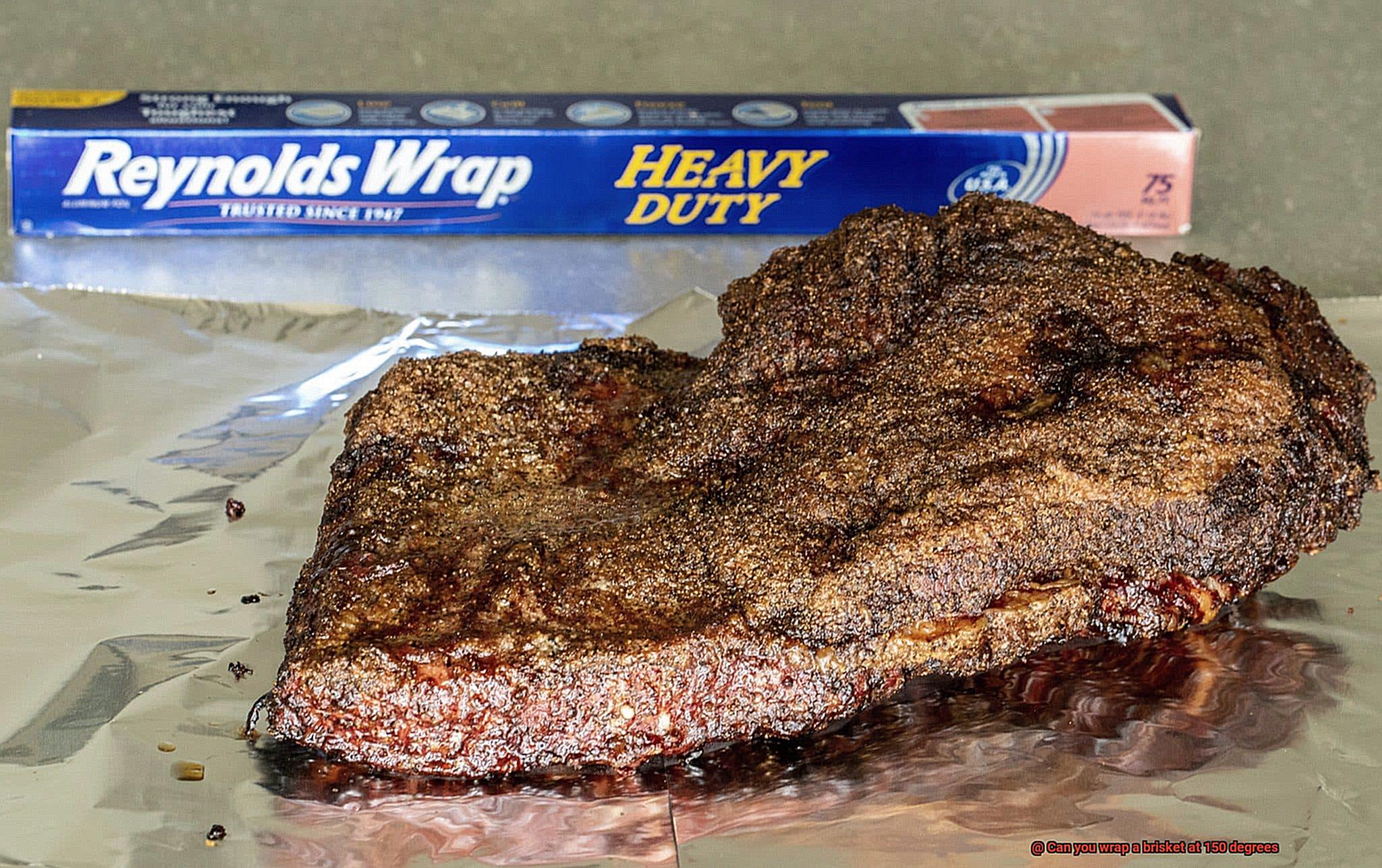
Wrapping also protects the brisket from harsh smoke or heat that could dry out or overcook the meat. It creates a barrier that prevents direct contact with the smoke and heat while still allowing enough airflow to infuse the meat with smoky flavor.
Benefits of Wrapping a Brisket at 150 Degrees
Smoking a brisket is a labor of love, requiring a delicate balance of patience, skill, and technique. One crucial technique that can make or break the final product is wrapping the brisket at the optimal time and temperature. But why wrap a brisket at 150 degrees Fahrenheit? Let’s explore the benefits.
First and foremost, wrapping your brisket at 150 degrees Fahrenheit helps to lock in moisture, ensuring a juicy and flavorful end result. As the brisket cooks, it releases moisture through evaporation. Wrapping it in foil or butcher paper creates a moist environment that traps that precious moisture inside, transforming your brisket into a tender, succulent masterpiece.
But that’s not all. Wrapping also speeds up the cooking process while preserving tenderness and flavor. When left unwrapped, a brisket can take hours to reach its ideal internal temperature of around 200-205 degrees Fahrenheit. By wrapping it at 150 degrees, you accelerate the cooking time without sacrificing texture or taste.
Additionally, wrapping at 150 degrees helps to create a more even cook throughout the brisket. Uneven cooking can leave certain parts dry or tough, but wrapping creates a controlled environment that ensures even cooking from end to end.
Potential Drawbacks of Wrapping a Brisket at 150 Degrees
As a pitmaster, you know that wrapping your brisket is an essential step in the smoking process. But have you ever considered the potential drawbacks of wrapping your brisket at 150 degrees Fahrenheit? While it may seem like a good idea for speeding up the cooking process and retaining moisture, there are some negative consequences to consider.
Firstly, let’s talk about the bark. The bark is what gives your brisket that delicious, crispy exterior we all crave. Wrapping your brisket too early can trap in moisture and steam, which can soften the bark and prevent it from forming properly. You don’t want a soft and mushy bark ruining your barbecue dreams.
Additionally, wrapping at 150 degrees can cause uneven cooking. Wrapping too early can cause the internal temperature to rise too quickly, leading to parts of the brisket being overcooked or undercooked. We all know that perfectly cooked brisket is worth its weight in gold.
Lastly, wrapping too early can impact the smoke flavor of your brisket. Smoke particles adhere better to meat that has not been wrapped. Wrapping at 150 degrees can limit the amount of smoke that your brisket absorbs, resulting in a less smoky flavor. And let’s face it – smoky flavor is what makes BBQ so irresistible.
Tips for Wrapping a Brisket at 150 Degrees
Wrapping your meat in foil or butcher paper can help tenderize and retain moisture, but there are some crucial tips to keep in mind.
Choose the right wrapping material
The type of wrapping material you use can make a big difference in the final product. Butcher paper is a popular choice among pitmasters and grillers because it allows the meat to breathe while also keeping in moisture and flavor. Foil is another option, but it can create a steaming effect if wrapped too tightly.
Wrap tightly but not too tight
Wrapping your brisket too tightly can impede airflow and cause the meat to steam instead of smoke. Conversely, wrapping it too loosely can result in dry meat. Finding the right balance is key – create a seal that keeps juices and flavors inside without compressing the meat.
Time it well
Timing is crucial when it comes to wrapping your brisket at 150 degrees. Some experts recommend waiting until the internal temperature of the meat reaches 160-170 degrees Fahrenheit before wrapping, while others prefer to wrap at the 150-degree mark. Experiment with different timings based on your cooking style and equipment.
Add flavor
Wrapping your brisket presents an opportunity to infuse extra flavor into the meat. Apply any seasonings or marinades before wrapping so that they have time to permeate the meat. This will help create a delicious crust on the outside.
Practice makes perfect
As with any cooking technique, practice makes perfect when it comes to wrapping your brisket at 150 degrees. Try both wrapped and unwrapped methods to see what works best for you and your taste preferences.
Best Practices for Wrapping a Brisket at 150 Degrees
Wrapping your brisket at 150 degrees can make all the difference in terms of flavor and tenderness, but it requires finesse. As an expert on the subject, I’m here to guide you through the best practices for wrapping a brisket at 150 degrees.
Timing is crucial when it comes to wrapping a brisket. Your meat should reach an internal temperature of 150 degrees before you wrap it. This ensures that the meat has had enough time to develop its smoky flavor. If you wrap it too early, you risk steaming the meat instead of smoking it, which can result in a dry and tough brisket.
Once your brisket has reached the desired temperature, it’s time to wrap it up. Butcher paper is the preferred choice for many pitmasters as it allows for more air circulation than foil, giving your meat a deeper smoky flavor.
When wrapping your brisket, make sure to tightly wrap it to prevent any juices from escaping. Place the brisket fat-side up in the wrap to protect it from heat and moisture loss. This will help keep your meat juicy and flavorful.
After wrapping, place the brisket back on the smoker or grill and continue cooking until it reaches an internal temperature of 195-205 degrees. The estimated cooking time is around 4-6 hours depending on the size of your brisket.
Once your brisket has reached its final temperature, remove it from the heat source and let it rest for at least 30 minutes before slicing. This resting period is crucial as it allows the juices to redistribute throughout the meat, resulting in a more tender and flavorful end product.
To recap, here are the best practices for wrapping a brisket at 150 degrees:
- Make sure your meat has reached an internal temperature of 150 degrees beforehand
- Use butcher paper for wrapping
- Tightly wrap the brisket and place it fat-side up
- Continue cooking until it reaches 195-205 degrees
- Let it rest for at least 30 minutes before slicing
Alternatives to Wrapping a Brisket at 150 Degrees
In this section, we’ll explore some exciting and innovative options that will elevate your brisket smoking game.
Spritzing is one alternative that can keep your brisket moist and flavorful. This method involves spraying your brisket with a liquid every 30-60 minutes during the smoking process. Apple juice, cider vinegar, and beef broth are popular choices that can add a unique taste to your meat. Not only does spritzing provide moisture, but it also helps to create a flavorful bark.
Using a water pan in the smoker is another alternative that can prevent the brisket from drying out. The water pan helps regulate the temperature in the smoker and creates a humid environment. It’s crucial to refill the water pan regularly throughout the smoking process.
If you want to add flavor and moisture to your brisket before smoking it, using a dry rub or marinade is an excellent option. A simple dry rub recipe includes equal parts salt, pepper, and garlic powder. On the other hand, mixing soy sauce, Worcestershire sauce, and brown sugar together makes for an amazing marinade. These methods can enhance the taste profile of your brisket, making it more delicious.
Lastly, some pitmasters choose to smoke their brisket unwrapped for the entire cooking process. Though this may result in a drier exterior, it allows for a deeper smoke flavor and bark on the meat. This method is great for those who prefer a smokier taste or want to experiment with new flavors.
P3uxKyshonE” >
Conclusion
In the world of smoking meat, wrapping a brisket is a make-or-break step that can either elevate your dish to new heights or leave you with a dry, tough piece of meat. While opinions vary on when and how to wrap, many pitmasters swear by the 150-degree Fahrenheit mark as the perfect time to get your brisket wrapped up and ready for cooking.
Why do so many experts recommend this temperature? Wrapping at 150 degrees allows you to speed up the cooking process while still retaining moisture and tenderness in your meat. The right wrapping technique can also create more even cooking throughout your brisket and infuse extra flavor into every bite.
But before you start wrapping away, it’s important to find that sweet spot between wrapping too early or too late and choosing the right material for your wrap. While there are numerous benefits to wrapping your brisket – like locking in moisture and speeding up cook time – there are also potential drawbacks like impacting the bark formation, uneven cooking, and limiting smoke absorption.
So, how do you wrap your brisket successfully at 150 degrees Fahrenheit? Follow some best practices like timing it well, using butcher paper for a tight but not overly-tight wrap, placing fat-side up in the wrap, continuing cooking until it reaches 195-205 degrees Fahrenheit, and letting it rest before slicing.
Of course, if you’re looking for alternatives to wrapping at 150 degrees Fahrenheit, there are plenty of other options out there. Spritzing with liquids like apple juice or using water pans can help retain moisture while dry rubs or marinades can enhance flavor profiles. And if you’re feeling daring, smoking unwrapped can result in deeper smoke flavors that will take your brisket to new heights.
No matter which method you choose, remember that practice makes perfect when it comes to achieving that perfectly cooked and juicy brisket.

